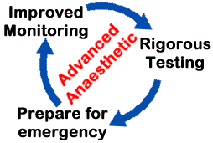
Vetrica Policies – Advanced Anaesthetics Reduce Risk
At Vetrica, we’re constantly striving to improve anaesthetic safety. As has been described in the previous pages, we use a balanced anaesthetic regime with heavy use of pain relief, allowing us to use minimal doses of anaesthetic agents. The majority of animals under anaesthetic are monitored electronically using pulse oximetry; we routinely use propofol anaesthetic induction, nitrous oxide and isoflurane; we always wear sterile surgical gloves and never use animal bi-product suture materials. This is an excellent, standard anaesthetic regime delivered at a very competitive price.
Experience shows that the majority of problems encountered during anaesthesia are due to one of two things:
- Pre-existing disease that was undetected prior to anaesthesia
- Poor quality monitoring during anaesthesia.
At Vetrica, we have invested heavily in monitoring and testing equipment, so we now have the ability to mitigate against both of these problems.
The Vetrica Advanced Anaesthetic
The Vetrica Advanced Anaesthetic has the additional features of blood and urine testing; heart and respiratory monitoring; and extra precautions in case of emergency. Taking these three features in turn:
Rigorous Testing
By conducting a full pre-anaesthetic blood and urine profile we can detect many of the pre-existing diseases that complicate anaesthesia.
Heart and Respiratory Monitoring
This is a picture of our respiratory and electrocardiograph monitor. This piece of equipment delivers real-time information about the electrical activity of the heart, and the rate and quality of breathing. It also functions as a gas analyser, determining the concentrations of expired gases. Alarms are sounded if breathing or heart rate fall outside acceptable limits, generally long before a person monitoring the patient would notice, and in plenty of time to intervene before the patient is adversely affected.
Prepare for Emergency
Also part of the Vetrica Advanced Anaesthetic is the placement of an intravenous cannula. This is a small plastic tube inserted into a vein, and held in position with sticky tape. This gives immediate access to a vein in the event of an emergency. With a standard anaesthetic, all injections are given directly into a vein using a syringe and needle. This is fine when there is no pressure on the nurse or surgeon at the beginning of an anaesthetic procedure; but if there’s a sudden emergency during an anaesthetic, and a drug needs to be given immediately into a vein then having a cannula in can literally be a life saver. By preparing in advance for an emergency like this, anaesthetic risk is reduced.
By rigorously testing for pre-existing conditions, using propofol, monitoring the heart and breathing electronically, and preparing for emergency by placing a cannula before anaesthetic, the anaesthetic risk can be reduced to as low as possible.
Vetrica Advanced Anaesthetic Plus
When an anaesthetic is expected to last more than one hour, all patients that are anaesthetised using the Vetrica Advanced Anaesthetic will be given intravenous fluids for the whole of the time under anaesthetic. If a shorter procedure becomes more prolonged, from the point at which it becomes clear that it will go on for more than an hour, intravenous fluids will be supplied. This is important because anaesthetic procedures have a dehydrating effect on a patient. The longer an anaesthetic goes on the greater this effect, especially if there has been any significant blood loss. By replacing lost fluids intravenously, blood flow to the important organs is protected, and this reduces risk.
For peace of mind, the Vetrica Advanced Anaesthetic, and Advanced Anaesthetic Plus offer the greatest degree of safety. These procedures are particularly suitable for older or overtly ill animals, but bearing in mind that most unexpected anaesthetic deaths occur in otherwise healthy animals, we recommend them for all our patients. As a general guide, the younger and healthier an animal is, the less likely complications are to arise. Geriatric animals, that’s cats and dogs over eight years old, giant breeds of dog over six years old, really ought to have the Advanced Anaesthetic, but in most cases the decision remains with you.
Our standard anaesthetic is superb on its own, surpassing normal expectations of veterinary anaesthesia. The Advanced Anaesthetic improves this still further, setting cost factors aside to provide only what’s best for the patient. Insured animals will automatically receive an Advanced Anaesthetic unless specified otherwise, and this is how members of staff’s pets at Vetrica are treated, but no-one should feel that their pet is being neglected without the Advanced options.
Costs
The Advanced Anaesthetics involve many additional costs in drugs, equipment and time that simply could not be supplied at the highly competitive price of a standard anaesthetic. There are occasions when an Advanced Anaesthetic will be strongly advisable, but in most cases the decision is with you, the patient’s owner.
HAVE A QUESTION OR WANT TO FIND US Click here

